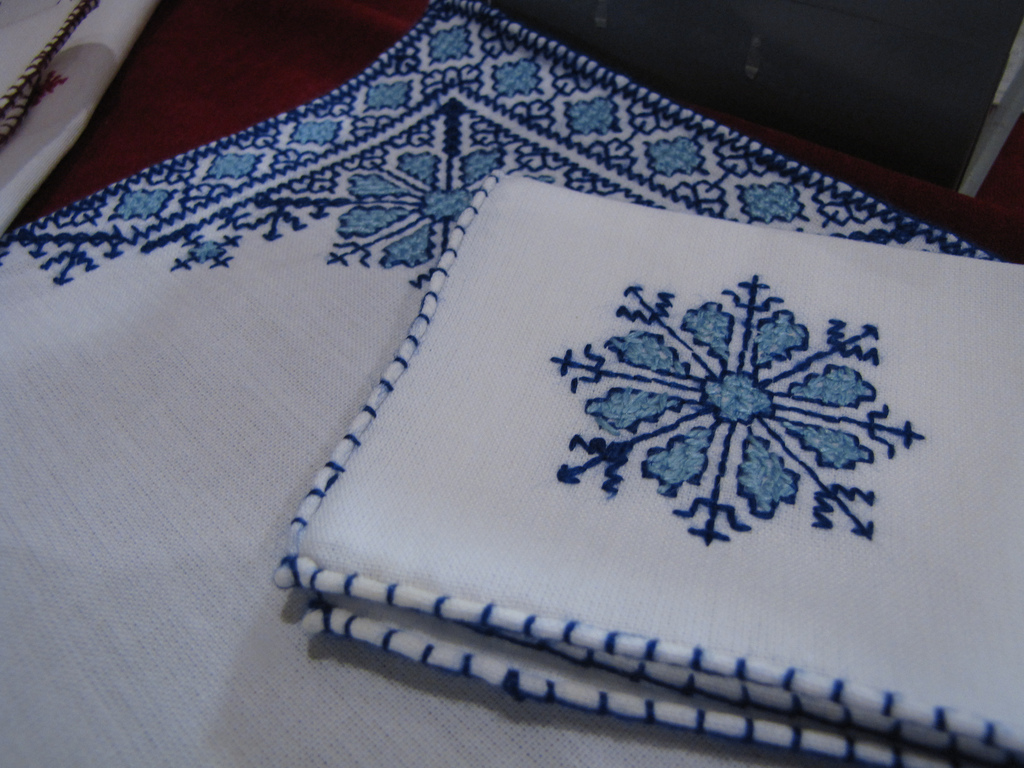Embroidery is the art of decorating fabric with thread or yarn utilizing a needle. Embroidery designs can range from simple and beginner friendly to laborious and intricate.
The most arduous designs are those stitched by hand instead of a stitching machine.
Embroidery is ancient, to say the least, as it traces back to 30 000 B.C. While China is one of the oldest cultures to embrace it, this art form is been practiced all over the world with Morocco being no exception.
Moroccan embroidery, called “Tarz” is an ancestral art that has been handed down from generation to generation. It is a female-dominated urban craft; a means by which talented townswomen have always told their tale of creativity merged with extensive experience.
Tarz is omnipresent in all Moroccan households in one form or another be it in everyday household textiles, traditional clothing, or refined décor.
Embroidery stitching techniques
Based on the type of technique used to generate each stitch, stitches are divided into stitch families. Some of the most popular ones are as follows:
In , each stitch is connected to the next through a loop.
Cross stitches comprise diagonal stitches that cross each other from the middle forming an X.
backstitch is where the needle is taken backward into the preceding stitch instead of forward.
A running stitch is the most basic of all stitching techniques and it consists of running the needle up and down the fabric at an even distance forming a straight line.
A slip stitch as its name suggests is slipped into the fabric folds so as to be concealed
A whipstitch goes diagonally over the unhemmed edges of the fabric.
Different styles of Embroidery
Although some embroidery techniques are universal, some features thereof are culture-specific Moroccan embroidery for instance is known for its distinctive styles named after their town of origin. These are Chefchaouen, Fes, Meknes, Tétouan, Rabat, Sale and Azemmour.
Fesi embroidery
Fesi embroidery, also referred to as Tarz El Ghorza or dot embroidery is named after the cultural capital city of Morocco.
Fessi embroidery is known for its richness, a characteristic traced back to its Hispano-Moresque and French influences. The latter bred from France’s attempt to support Moroccan arts and crafts in WW1.
This proved to be counterproductive as it lead to the disappearance of many micro local styles that had a hard time fitting into the French mass production system.
The Fessi embroidery style is similar to cross-stitching but is double-sided by nature allowing for a reversible design whereby the front and back are 100 identical.
Fessi embroiderers carry out their tasks with their usual aplomb and self-assurance. An example of this is taking an irreversible step that embroiderers usually shy away from; drawing designs directly into fabric without tracing any patterns or marks beforehand.
Their confidence is matched with the great diligence and Meticulousness, shown in the counted thread embroidery techniques they employ.
This is where they methodically count out warp and weft in fabric. The result is a uniform and even floral or geometric design that is usually but not strictly symbolic.
Rbati Embroidery
The capital city of Morocco is renowned for its chic floss silk embroidery that splits into two types. The old school Rbati embroidery is a traditional style dating back to the 17th century. It incorporated blue, gold or red colored silk floss into even woven cotton. Popular motifs were styled figures and plants.
From the 19th century onwards, a more modern style was in town. This style captures the westernized side of the capital and incorporates it into loud complementary colored designs covering the surface of most of the foundation or ground fabric.
One of the most celebrated varieties of Tarz Rbati is the Goldwork embroidery.
The latter is a sign of high social status and luxury; reserved only for special occasion items like wedding dresses and traditional slippers. It can also be found on high-end cushions and wall hangings.
This is accomplished using the couching technique where a strong thread is used to secure gold threads on heavier fabric.
Meknesi Embroidery
Although the Meknesi style is non-reversible, this does not take away one bit from its regal nature. With a rhombus design centering smaller squares woven into a ground that is already embroidered with dozens of dots, rhombuses or stars.
These geometric designs are sometimes married with floral patterns combining the best of Berber and Fesi styles of embroidery.
Meknesi embroidery is known for its fusion of vibrant colors like red, blue, green, orange, yellow; purple, black and pink.
Meknessi Embroidery is also the base for the famous Moroccan Sebnia or head cover used after going to the bathhouse. To this, the embroiderer often adds colored silk tassels to the edges.
Meknessi embroidery can also be found on soft furnishings like Mendil or curtains.
Tetouani embroidery
The unique Tarz Tetouani or Taajira comes from the northern city of Tetouan and is largely recognized by its mix of Balkan and oriental style introduced by its Spanish and Turkish and Syrian expats.
Another characteristic of the Tetouani embroidery is its overlay of stitches, with the primary floral or geometric designs making use of bold and bright colors and the secondary ones being much smaller and in more muted shades.
For the motifs to pop up even more, they are individually outlined in black or green.
The choice of colors for both primary and secondary designs is complimentary to the ground color with the most popular picks being blue, royal blue, red, turquoise and white.
Tetouani Embroidery is commonly done on the surface of soft furnishings like curtains or, cushions and hangings.
Tetouani Embroidery is also usually associated with bridal/wedding objects like the tikka (trousers band) Kettafiya (rectangular shoulder cloth) and Tenchifa (mirror covers) and Ajar (horizontal bed hangings).
Azemmour Embroidery
Azemmour is a Moroccan coastal town located on the left bank of the Oum Er-Rbia River. The city has a unique selection of attractions to offer thanks to its Jewish and Portuguese influence. An influence that is reflected in its embroidery crafts.
In this style of embroidery, the ground fabric is filled with repeated motifs except for a band surrounded by two strips as the latter encompasses the main designs.
What makes the main designs quite distinctive is their representation of living creatures such as animals, birds, mythical creatures and female figures in addition to vases and foliage. The latter came in a band of embroidery surrounded by two strips.
In terms of techniques, this style of embroidery uses a combination of braid stitching for filling and cross-stitching on the individual motifs. The whole is in red, blue and black threads on linen cloth.
Most popular Moroccan Embroidery Items
Tablecloths
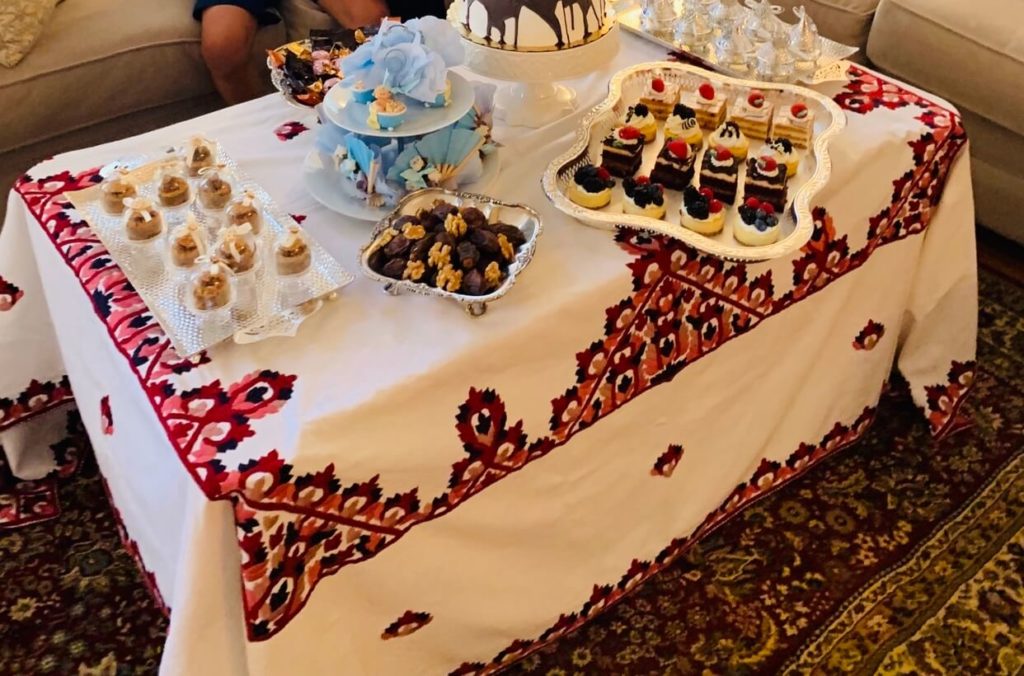
Luxury tableware is omnipresent in every Moroccan household but is reserved for special occasions only. With fancy tableware comes a need for matching tablecloths and napkins and Moroccan embroidery offers exactly that.
Handmade embroidered tablecloths and napkins are used as ornamental décor coverings rather than a protective layer due to their high value.
With embroiders spending up to several months creating them, the result is a refined piece of art that can upscale any.
While the ground fabric is often white, the embroideries themselves differ depending on the embroidery style adopted. Gold, green and blue are popular choices.
Caftans and Takchitas
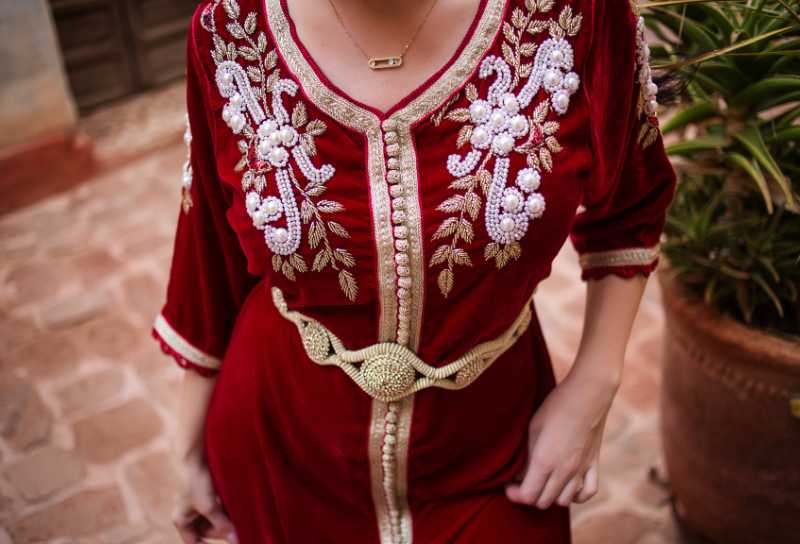
Morocco offers a large selection of versatile traditional clothes, particularly gowns in varying styles fit for different occasions for both genders.
Examples thereof include the everyday Djellaba, the hoodless K’miss, the one-layered Caftan, and the Takchita from least to most formal.
One thing that adds to these garments’ elegance and sophistication is their intricate embroidery work.
Each region in Morocco has its distinct style of caftan and Takchita embroidery. Typically, the embroidering is directly or loosely inspired by nature (butterflies, birds, flowers, etc.) and traced with beadings.
Leather Bags
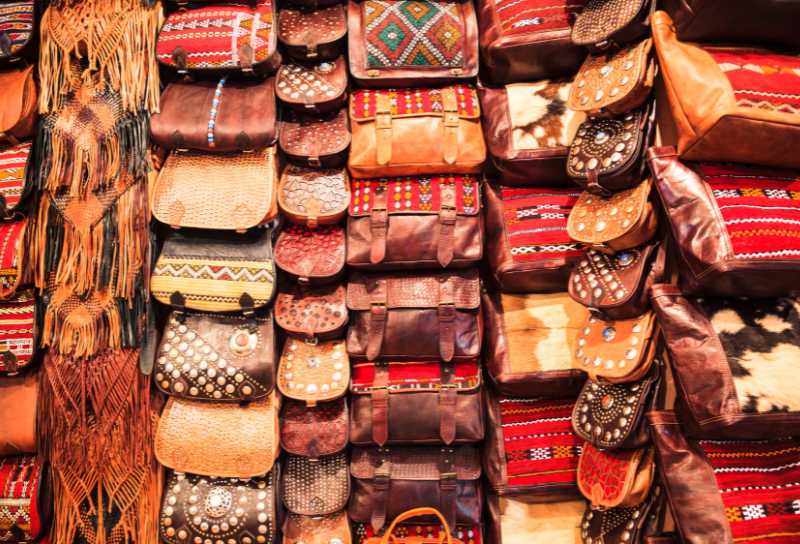
Moroccan leather is thought to be one of the best in the world. From Leather slippers, belts, jackets, poufs and skirts, all leather goods are cured, softened and dyed in tanneries in the same way for over a thousand years with Chouara Tannery in Fes being the largest, most popular and most picturesque one in the country.
The process does not stop here, as the ornamentation of leather is a traditional Berber craft that survived to this day to tell its tale. Although modernized, it is still strictly handmade and highly laborious. Embroidery can, however, be incorporated into leather goods differently by fusing leather with embroidered fabric.
Textile embroidery
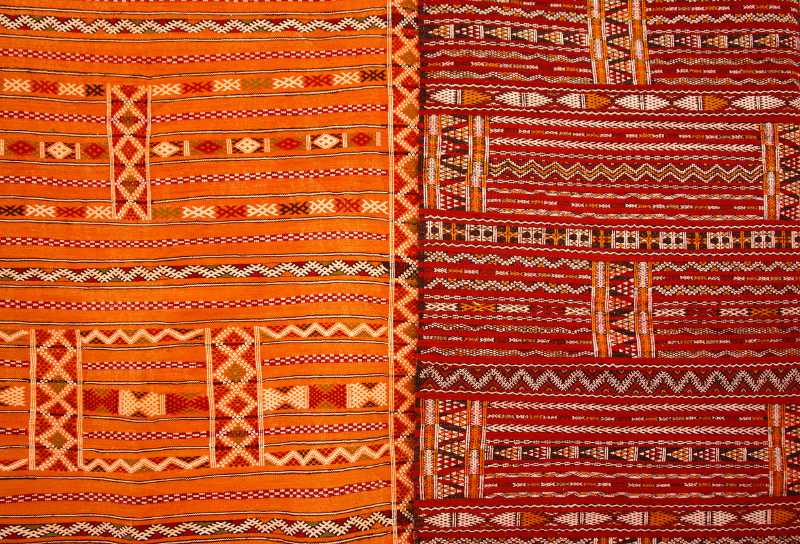
Textile production in Morocco has a rich history, to say the least, as it is said to have appeared around 1500 B.C.
Today, the textile industry in the country is female-dominated and passed down from accomplished artisans to beginners who will one day be masters of their crafts.
Characterized by its unique stitching; weaving; knotting and needlework and embroidery techniques, the Moroccan textile process is both lengthy and highly demanding.
Depending on their specialty, artisans can produce dazzling embroidered rugs, blankets, cushions, Handira blankets (bridal capes), furniture covers and clothing items.
Machine Embroidery
Although nothing can match the excellent artisanship, intensive labor and sentiments attached to hand embroidery, Machine-stitched embroidery items have gained massive popularity in Morocco due to their affordability in time and money.
What to expect when purchasing a Moroccan embroidered item
- Embroidered leather products, rugs and tablecloths are usually ready-made and available for purchase in old Medinas, such as the one in Fes and Marrakech, and traditional working-class neighborhoods around the country.
- Since the quality of readymade products varies wildly in Morocco, the only guidance that can be given here is to embrace the culture of bargain, as it is the case for sellers to sometimes overprice goods expecting that the buyer will cut a large portion of it.
- Other items such as embroidered Caftans and Takchitas, while they can be sold readymade, can be costume made to proportions by seamstresses and seamsters teaming up with embroiderers. These can be easily recognized as they showcase their creations in mannequins or window displays.
- The price of the down depends on whether it is stitched by hand or machine as well as the embroidery style, how heavy the work is and whether beading is involved.

